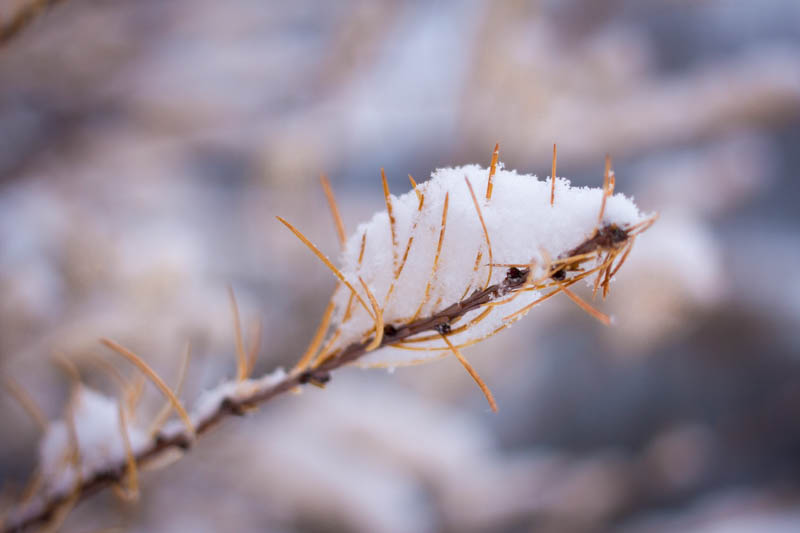For those not from around here, the tamarack is a deciduous tree with needles: that is, it's a fir tree in style, but it loses it's leaves/needles like a deciduous tree.
I decided to take a close-up, which I won't actually call a macro because it's not that tight. First, I took the above shot with a small f8 aperture. The rule is: the smaller the aperture that you use, the greater the depth of field (or detail if you like) that you get in the photo. So, although they're fuzzy, we can see all of the branches in the background. The photo is too busy for my taste and not good at all.
So, then I opened the aperture to f2.8, which is quite wide, and took the next photo.
With less detail in the background (although even less would be better but that's all this lens could do) the branch of focus stands out much better. There is no question of what the focal point is. This photo just works much better than the first one. So, if you have a camera which allows you to control the aperture, go ahead and use it to your advantage.
Note 1: It seems confusing but the smaller the number of the aperture or f-stop, the larger the aperture. So, f2.8 is a much more open aperture than f16, foe example.
Note 2: Aperture controls DOF or Depth-of-Field. A large aperture (small f#) leads to a shallower DOF than a small aperture (large f#) which results in more of the photo being in sharp focus.
Note 3: DOF or depth-of-field can make or break a photo. The general rule is that you would like shallow DOF on a macro and a large DOF on a landscape photo where you normally want to see good detail from front to back. Of course, it's just a general rule — so perhaps I should call it a guideline.
Note 4: I did very little post processing on either photo. They are close to what one would see on the back of the camera.
----------------------
By way of contrast (and having nothing to do with the point of this post), here is a tamarack from the same area, just a few days earlier. It's very pretty when the leaves turn yellow, especially because they hang on for quite awhile after the 'normal' deciduous trees are bare.



The bald cypress we have in our community also turn color in the fall to a beautiful orange, then lose their needles as well. Interesting shots.
ReplyDeletewhoever set up the f-stop stuff should be flogged! my brain has a blockage in trying to learn smaller is wider, etc. well, my brain has a blockage in learning a lot of photography mechanics.
ReplyDeleteThe tamarack? Rather like the larch--it too is a conifer which loses its leaves (needles) like a deciduous tree.
ReplyDeleteI prefer the second though with my macro lenses getting any thing over about an inch in focus is an achievement.
ReplyDeleteI'm with Tex. Aperture had always frustrated me terribly. I tend to stick with shutter speed preferred and use that to take best advantage of the light.
ReplyDeleteWould you believe that I had no idea about tamaracks until I moved up here last autumn and saw so many "yellow pines?" I wondered if trees were dying or were they normal. I soon learned but it was a new revelation for this city girl. And even for Frank. ;)
The tamarack looks like it is holding its hand out to catch a bit of snow....
ReplyDeleteLovely photograph. Great explanation on f stops. I don't know much about f-stops, but I do know that it is backward (number-wise) from what one would think. Always confuses me. But I'm easily confused, anyway.
:)))
Smiles,
Jackie
Another easily understandable explanation of photo terminology, AC, and the accompanying photos are good illustrations. While I know you would not wish for early snow,mit is still beautiful to me.
ReplyDeleteThese remind me of the larches I saw in Canada. I work hard to get the math of lenses but I always have to stop and think when I start again.
ReplyDeleteI dropped my camera again, and life here is out of focus.
ReplyDeleteTamaracks are especially beautiful this time of year. I prefer the photos here with shallow depth of field too.
ReplyDeleteI was confused by focal length until I got a picture in my mind of how it works.
ReplyDeleteImagine a hole, with rays of light shining through it. If the hole is big, the rays of light spread out all around the hole and the edge rays are close to the hole as they pass through. (get a stick and put it through the hole with as much slant as possible. see how close the ends of the stick are at the edge? That is short focus.)
If the hole is tiny, the ray of light passing through cannot get close to the edge. that is long focus.
And I think a tamarack and a larch are much the same thing.
Nice needle shot, AC
I like the word "Tamarack". And the way you make some of these "rules" and "guidelines" easy to understand. I don't think it's going to help my iphone photos, but I like reading about it.
ReplyDeleteGreat examples of how to use f-stops. The 2nd one with the larger aperture has that dreamy background and lets the subject shine. Beautiful job!
ReplyDeleteNice ! I shoot in Raw and that gives me the ability to either adjust or not ! Great info your giving here for people ! Thanks for sharing , Have a good day !
ReplyDeleteI've never seen, or even heard of, this tree. Beautiful photos! I see there's a lot to learn on your blog.
ReplyDelete